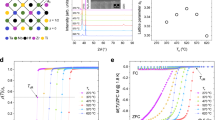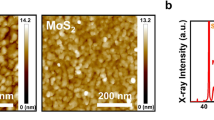Abstract
One of the important problems for electrical applications of high-temperature superconductors1–3 is the contact resistance between the superconductor and a normal metallic wire. Recently, AT&T Bell researchers4 reported that the contact technique limited measurements of a critical current in their Y–Ba–Cu–O samples: even after necking the cross-section down to 2 x 10−3 cm2, the sample stayed superconducting, the current through the contacts being limited to ∼2 A. Apparently contacts are a real problem, because the very high critical-current densities as reported recently by IBM laboratories5 have been measured on films with contact resistances of ∼20 Ω, and a pulsed-current method had to be used. Here we report a simple method of contact preparation for high-Tc copper-oxide materials (Y–Ba–Cu–O). Based on high-temperature metallization it reduces the contact resistance from typically 1 Ω mm−2 down to ≲lOμΩmm−2 (77 K), and enables us to measure the critical current of a bulk sample, with current densities in the contact area in excess of 2,000 A cm−2.
This is a preview of subscription content, access via your institution
Access options
Subscribe to this journal
Receive 51 print issues and online access
$199.00 per year
only $3.90 per issue
Buy this article
- Purchase on Springer Link
- Instant access to full article PDF
Prices may be subject to local taxes which are calculated during checkout
Similar content being viewed by others
Author information
Authors and Affiliations
Rights and permissions
About this article
Cite this article
van der Maas, J., Gasparov, V. & Pavuna, D. Improved low contact resistance in high-Tc Y–Ba–Cu–O ceramic superconductors. Nature 328, 603–604 (1987). https://doi.org/10.1038/328603a0
Received:
Accepted:
Issue Date:
DOI: https://doi.org/10.1038/328603a0
This article is cited by
-
Ion beam and thermally-induced interface reaction between highT c superconductor thin film and metal overlayer
Bulletin of Materials Science (1991)
-
Effect of heat treatment on Ag/Y-Ba-Cu-O contact resistance
Pramana (1989)
-
Structural study of annealed Ag-YBaCu3O7 interfaces
Journal of Materials Science Letters (1989)
-
Nature of contact resistance in high-T c YBa2Cu3O7?? Superconductors
Applied Physics A Solids and Surfaces (1989)
-
Percolation and electronic properties of superconducting (YBa2Cu3O7?? )1?x Ag x ceramics and thick films
Journal of Superconductivity (1989)
Comments
By submitting a comment you agree to abide by our Terms and Community Guidelines. If you find something abusive or that does not comply with our terms or guidelines please flag it as inappropriate.



